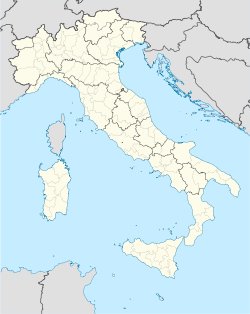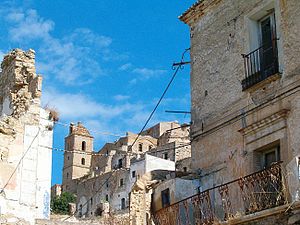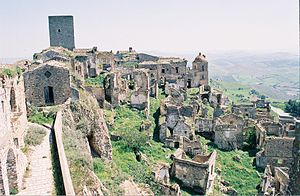- Craco
-
Craco — Comune — Comune di Craco Craco Location of Craco in Italy Coordinates: 40°23′N 16°26′E / 40.383°N 16.433°ECoordinates: 40°23′N 16°26′E / 40.383°N 16.433°E Country Italy Region Basilicata Province Matera (MT) Frazioni Craco Peschiera Area - Total 76 km2 (29.3 sq mi) Elevation 391 m (1,283 ft) Population (December 2008)[1] - Total 773 - Density 10.2/km2 (26.3/sq mi) Demonym Crachesi Time zone CET (UTC+1) - Summer (DST) CEST (UTC+2) Postal code 75010 Dialing code 0835 Patron saint San Nicola Website Official website Craco is a commune and medieval village located in the Region of Basilicata and the Province of Matera in Italy. About 25 miles inland from the Gulf of Taranto at the instep of the “boot” of Italy. The medieval village of Craco is typical of the hill towns of the region with mildly undulating shapes and the lands surrounding it sown with wheat.
Craco was built on a very steep summit, for defensive reasons, giving it a stark and striking appearance and distinguishing it from the surrounding lands which are characterized by soft shapes. The centre, built on the highest side of the town, facing a ridge runs steeply to the southwest where newer buildings exist. The town sits atop a 400 metre high cliff that overlooks the Cavone River valley. Throughout the area are many unique vegetation-less mounds formed by intensive erosion that are called "calanchi."
History
Around 540AD the area was called “Montedoro” and inhabited by Greeks who moved inland from the coastal town of Metaponto. Tombs have been found dating from the 8th century suggesting the original settlement dates back to then. The town’s name can be dated to 1060 when the land was the possession of Archbishop Arnaldo, Bishop of Tricarico, who called the area “GRACHIUM” which means "from the little plowed field." This long association of the Church with the town had a great influence on the inhabitants.
From 1154-1168 the control of the village passed to Eberto who established the first feudal control over the town. Then in 1179, Roberto di Pietrapertos became the landlord of Craco. In 1276 a university was established in town. During this period in the 13th century the landmark castle was built under the direction of Attendolo Sforza. In 1293 under Federico II, the Castle Tower became a prison. By the 15th century, four large plazas had developed in the town: Palazzo Maronna near the tower, Palazzo Grossi near the big church, Palazzo Carbone on the Rigirones property, and Palazzo Simonetti.
The inhabitants of the town went from 450 (1277), to 655 (1477), and 1,718 (1532) until reaching 2,590 in 1561; and averaged 1,500 in succeeding centuries. During 1656 a plague struck with hundreds dying and reducing the number of families in the town.
By 1799 there the townspeople had enough and overthrew the feudal system and Innocenzo De Cesare, returned to Naples, where hed had studied, and promoted an independent Municipality. Susequentley the town fell under the control of the Italian King and thereafter ruled by a period of French occupation. By 1815 the town was large enough to divide it into two districts: Torrevecchia – the highest area adjacent to the castle and tower, and Quarter della Chiesa Madre – the area adjacent to San Nicola’s Church
With the unification of Italy there was a growth of “brigands” in the area who plagued the town until the mid-1860s. With the end of the civil strife the greatest difficulty the town faced became environmental and geological.
From 1892 - 1922 over 1,300 Crachesi migrated to North America because poor agricultural conditions created desperate times as the land was not producing enough for the people.
During the mid-twentieth century, recurring earthquakes began to take a toll on the viability of the town. Between 1959 and 1972, portions of the village were severely damaged and rendered uninhabitable by a series of frana, or landslides. The geological threat to the town was known to scientists since 1910, due to Craco's location on a hill of Pliocene sands overhanging the clays, with ravines causing progressive incisions. For safety the entire population of 1,800 residents moved to a valley in Craco Peschiera 1963 leaveing the town uninhabited.That population is now down to about 970 inhabitants.
Churches are central to the town’s history with its founding stemming from monks. Noteworthy buildings include the church of the Observant Friars Minor dedicated to St. Peter, which dates back to 17th century and has now been partially restored and used as a conference center.
The church of Santa Maria della Stella, a small chapel built on the hillside is part of an active association paying homage to the Virgin Mary. The site of the chapel is the location where the statue of the Virgin and Child was miraculously discovered in a body of water by a shepherd. The statue of the Virgin is still housed there, although the original infant was stolen and replaced.
There is also a small new church in Sant’ Angelo, the only remaining section of the hilltop that is still inhabited, which houses the religious relics of the mummified body of St. Vincenzo - the martyred patron saint of the town. It is actively attended to with fresh flowers brought into the church daily. San Vincenzo was a soldier in the Legion of Tebea, the army of General Massimiliano in 286 CE who was martyred because he refused to renounce Christianity and worship the Emperor Marco Aurelio. His relic was brought to the town in 1769 and moved to the new little church after the old town collapsed. A story is told of another town, Pisticci, claiming the relic should be in their town and a group from there tried to take the relic. It became too heavy for them to carry very far and was abandoned on the road where the people of Craco found it and returned it to the town.
There is one other church in the town old town, Chiesa Madre (di San Nicola Vescovo - St. Nicholas Bishop). Its arched dome stands above the skyline just below the Tower and was the largest church in the village.
With the collapse of the old town, the statuary and interior fixtures were moved to the new church building which in now at the center of the new town, Craco Peschiera. Although modern in appearance on the outside, the old statues inside from the original church provide a transition to visitors that give them the atmosphere of old Craco.
This strong religious connection in the town generates many regularly scheduled festivals:
- Madonna della Stella Festival – first Sunday of May in Craco Vecchia
- San Nicola Festival – second Sunday in August
- Madonna della Stella Festival – second Sunday of August in Craco Peschiera
- Madonna di Monserrato Festival – third Sunday of September
- St. Vincenzo Martire Fair – fourth Sunday of October
- St. Vincenzo Fair – fourth Saturday of October in Craco Vecchia
The agricultural traditions of the town also continue with a local market held in Craco Perschiera each month.
Because of its unique and particular landscape Craco has been the setting of many movies, such as King David by Bruce Beresford, Saving Grace by Tom Conti, The Nativity Story by Catherine Hardwicke, Quantum of Solace by Marc Forster and The Passion of The Christ by Mel Gibson, in particular Craco is the town that can be seen in the scene of the hanging of Judas.
References
External links
Basilicata · Comuni of the Province of Matera Accettura · Aliano · Bernalda · Calciano · Cirigliano · Colobraro · Craco · Ferrandina · Garaguso · Gorgoglione · Grassano · Grottole · Irsina · Matera · Miglionico · Montalbano Jonico · Montescaglioso · Nova Siri · Oliveto Lucano · Pisticci · Policoro · Pomarico · Rotondella · Salandra · San Giorgio Lucano · San Mauro Forte · Scanzano Jonico · Stigliano · Tricarico · Tursi · ValsinniCategories:- Cities and towns in Basilicata
- Communes of the Province of Matera
- Basilicata
- Former populated places in Italy
- Ghost towns in Italy
Wikimedia Foundation. 2010.




